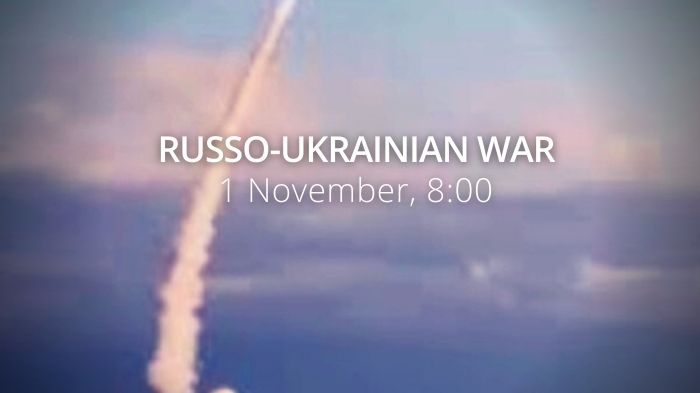Russian forces launched another massive wave of strikes against critical Ukrainian infrastructure, further damaging the power grid and leaving much of Kyiv without water. Overall, 60 missiles and 15 air strikes launched; more than 45 MLRS attacks carried out. More than 50 settlements hit. Ukrainian air defenses shot down 44 cruise missiles. Russian troops carry out the forced displacement of the civilian population, particularly in the Kherson Oblast, claiming the risk of Ukrainian forces destroying the Kakhovka dam and ordering "evacuations" of areas that could be flooded. Russian forces are continuing to withdraw from the west bank of the Dnipro River. Ukrainian troops conducted counter-offensive operations in northeastern Kharkiv Oblast, along the Svatove-Kreminna line and in Kherson Oblast on October 30 and 31. Russian forces continued ground attacks around Bakhmut on October 30 and 31. Russian occupation authorities in Kherson Oblast announced that they would allow the use of Ukrainian hryvnias alongside Russian rubles. 12 ships with 354.500 tons of agricultural products left the ports of Odesa, Chornomorsk and Yuzhny for the countries of Africa, Asia and Europe.
Daily overview — Summary report, November 1
Over the month of October 🇺🇦 has liberated approximately 2,535km² of Ukraine.
This means that 🇷🇺 currently occupies ~17.30% of Ukraine. ~0.42% less of the total area of the country than at the end of September. pic.twitter.com/0pQIn56HOn
— War Mapper (@War_Mapper) November 1, 2022
.
The General Staff’s operational update regarding the Russian invasion as of 06.00 am, November 1, 2022 is in the dropdown menu below:
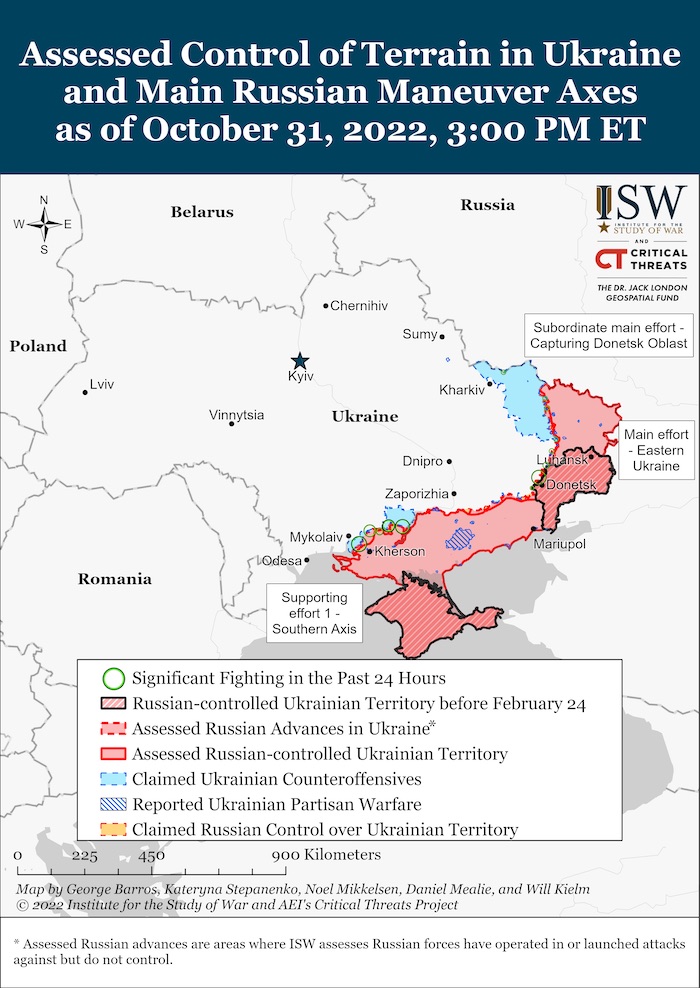
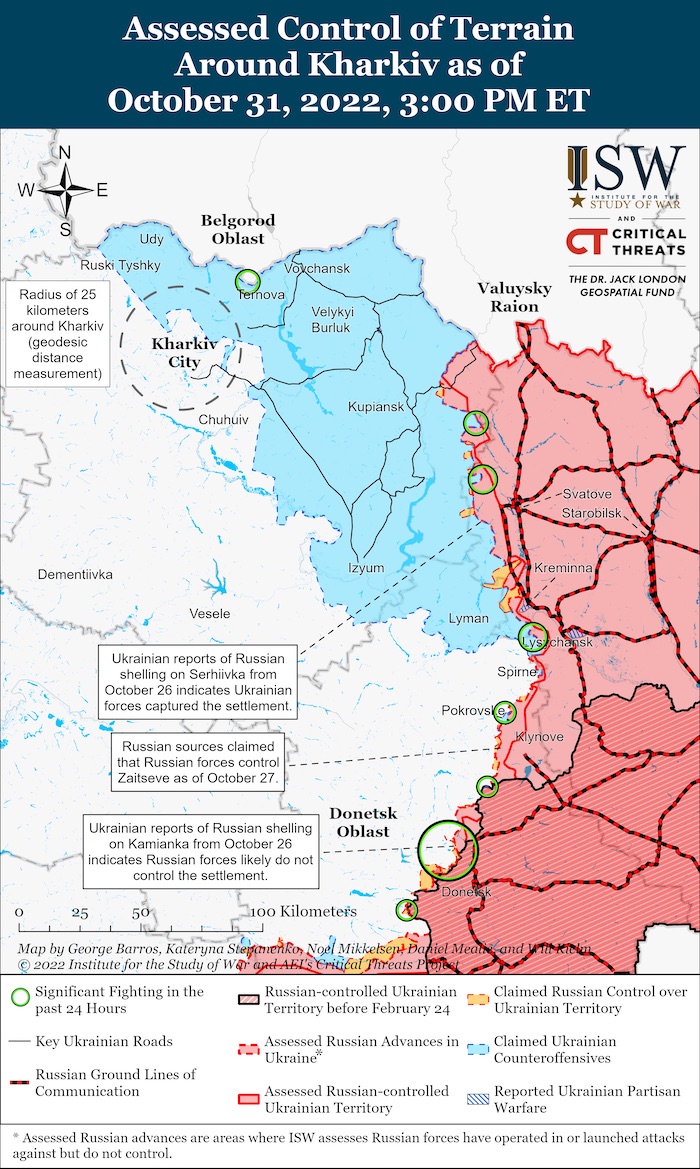
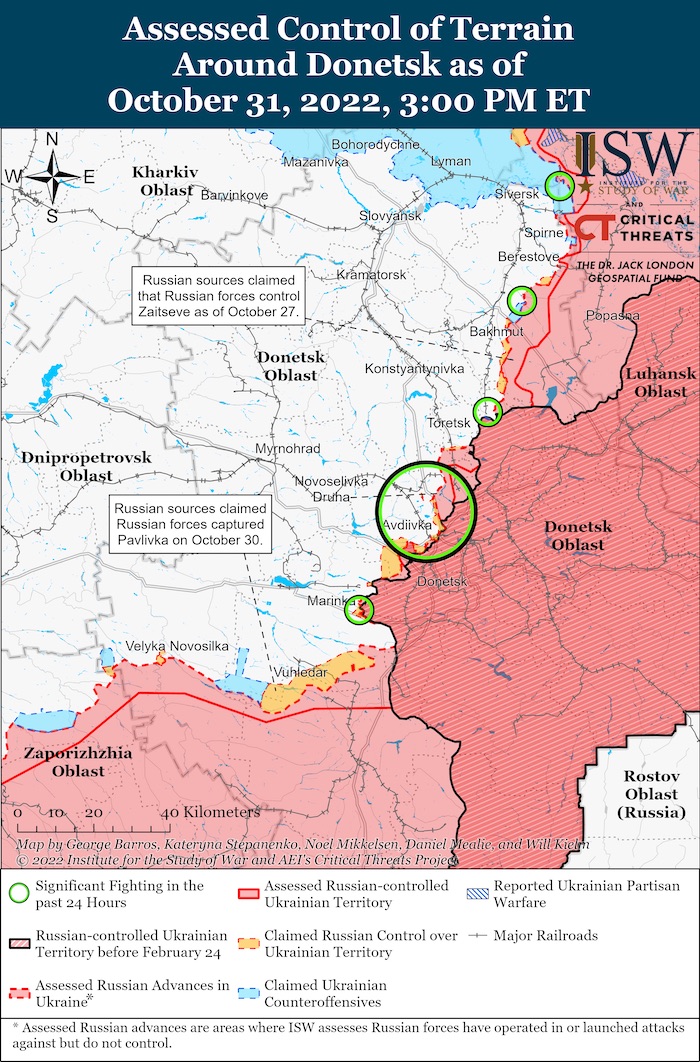
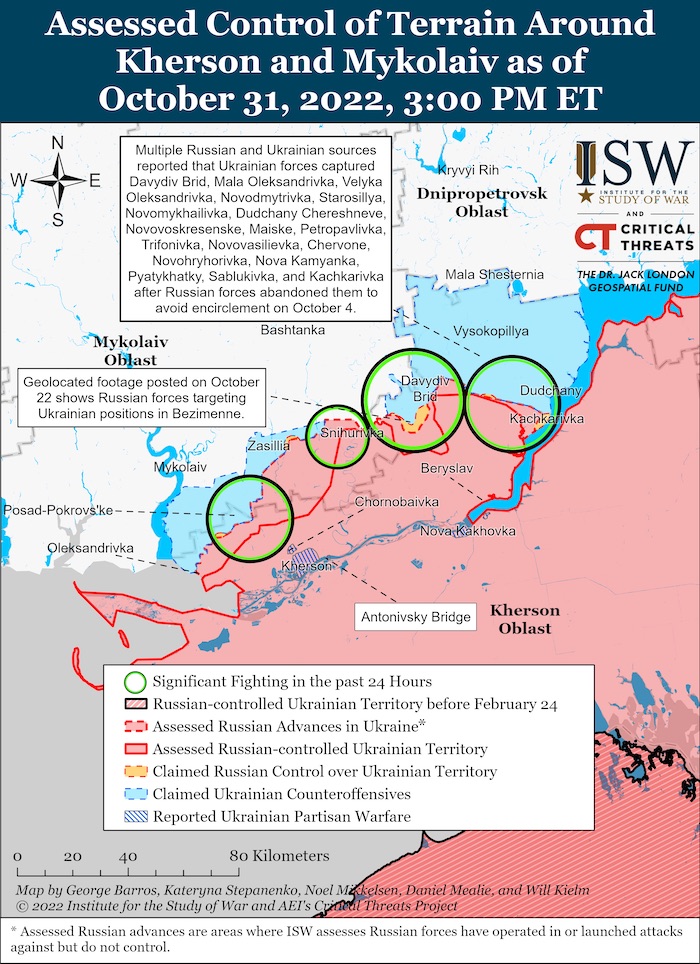
Military Updates
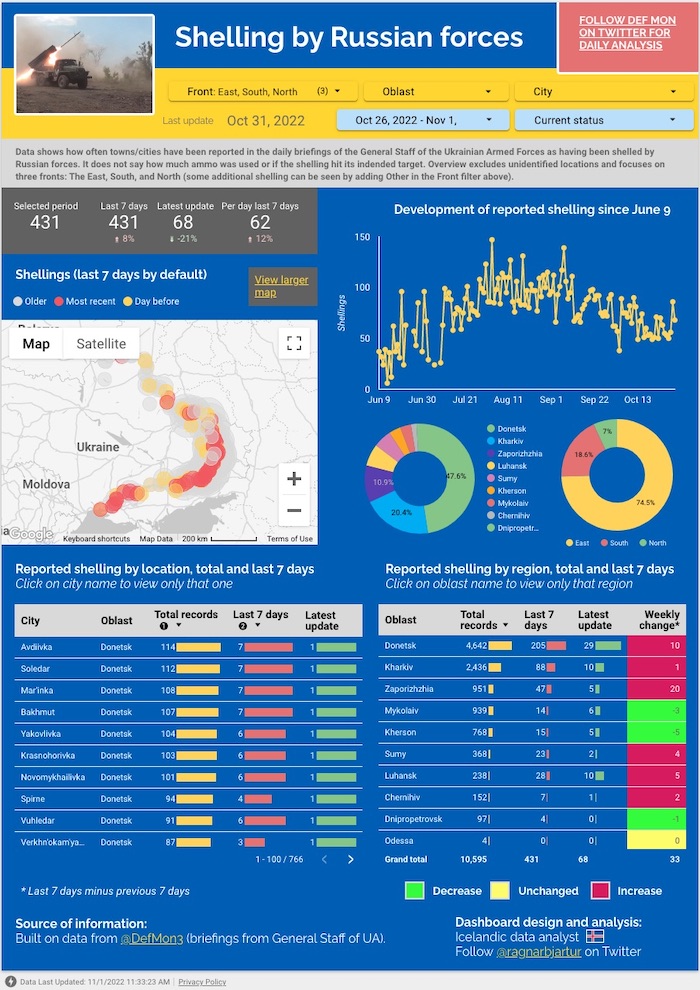
https://twitter.com/EuromaidanPress/status/1587220349216858112
At 07:00 AM, on October 31, the Russian occupiers carried out several waves of rocket attacks on Ukraine's critical infrastructure. More than 50 X-101/X-555 cruise missiles
from the north of the Caspian Sea and Volgodonsk (Rostov Region) were fired from Tu-95/Tu-160 strategic aviation missile carriers. 44 cruise missiles were destroyed by the forces and means of the Ukrainian Air Force.
Ukrainian air defense shot down 44 cruise missiles out of more than 50.
https://twitter.com/EuromaidanPress/status/1587255351698669569
Regional Updates
Map of Russia's Oct 31 missile/drone attackshttps://t.co/7dnXJVxlGc pic.twitter.com/auvZonyoQq
— Euromaidan Press (@EuromaidanPress) October 31, 2022
Air defense forces worked in Odesa, Mykolaiv, Kyiv, Dnepropetrovsk, Vinnytsia, Kirovohrad, Poltava, Kharkiv, Cherkasy, Khmelnytskyi, Lviv and Zaporizhzhia Oblasts. In Kyiv, interruptions in electricity and water supply and in Sumy, Zaporizhzhia, Kharkiv Oblasts power outages reported. Missiles and drones damaged 18 facilities, most were energy facilities. Hundreds of settlements in 7 regions of Ukraine were de-energized. Repair teams are working at full capacity.
Russia spent between $400 and $700 million on a morning missile attack on Ukraine. The Ukrainian Air Force Command said that Russia had fired more than 50 X-101/X-555 cruise missiles into Ukraine. The cost of the X-101 missile is $13 million, the cost of the X-555 is $7.5 million. The amount spent on the morning shelling of Ukraine exceeds half of the annual budgets of Novosibirsk or Yekaterinburg.
In Kyiv Oblast, as a result of a missile attack on Kyiv, a facility that provides electricity to about 350,000 apartments was damaged, said Kyiv Mayor Klitschko.
https://twitter.com/EuromaidanPress/status/1587183840531021827
In Dnipropetrovsk Oblast, 4 explosions reported. One missile hit an industrial enterprise in Kryvyi Ryh.
In Zaporizhzhia Oblast, the Russian troops attacked a critical infrastructure facility. Power outages reported.
Mi-2 helicopter found in ship container at Odesa Customs during searches
Currently, the @dbr_gov_ua investigators have confiscated the helicopter and are resolving the issue of transferring it to the Armed Forces' needs.https://t.co/whfH2pNKhI pic.twitter.com/xlfOraciDp
— Euromaidan Press (@EuromaidanPress) October 31, 2022
According to British Defence Intelligence, (last 48 hours):
https://twitter.com/DefenceHQ/status/1587387613496893441
- Imagery showed two MiG-31K FOXHOUND interceptor jets were almost certainly parked at Belarus’s Machulishchi Airfield on 17 October, with a large canister stored nearby within a protective earth berm. It is likely that the canister is associated with the AS-24 KILLJOY air launched ballistic missile, a large munition which the MiG-31K variant is adapted to carry.
- Russia has fielded KILLJOY since 2018, but it has not previously been deployed in Belarus. Russia has occasionally launched these weapons during the Ukraine war, but stocks are likely very limited.
- It continues to expend its advanced long-range munitions against targets of limited operational importance. With a range of over 2000km, basing KILLJOY in Belarus gives Russia little added advantage in terms of striking additional targets within Ukraine.
https://twitter.com/DefenceHQ/status/1587325946985684993
Losses of the Russian army
As of 1 November, the approximate losses of weapons and military equipment of the Russian Armed Forces from the beginning of the war to the present day:
These are the indicative estimates of Russia’s combat losses as of Nov. 1, according to the Armed Forces of Ukraine. pic.twitter.com/F5yhNPCNj5
— The Kyiv Independent (@KyivIndependent) November 1, 2022
Humanitarian
Abducted and tortured #Ukraine naval captain #Oleksiy_Kiselyov declares hunger strike in #Russia captivity #LetMyPeopleGo #StandWithUkraine #StopRussia #RussiaWarCrimeshttps://t.co/mIpu7vVORZ pic.twitter.com/ayzXM14m4w
— Halya Coynash (@halyapuff) November 1, 2022
️Legal
https://twitter.com/EuromaidanPress/status/1587204027292569601
Support
https://twitter.com/EuromaidanPress/status/1587147494269526018
New Zealand sanctioned Russian propaganda media and Wagner Mercenary Group. “We are imposing sanctions on 14 individuals and seven entities as part of our continued support to Ukraine. The list includes military personnel, defense structures and their heads, Russian-controlled disinformation media, as well as a paramilitary organization and its command,” said New Zealand Foreign Minister Nanaya Maguta.
New Developments
Russian morning attack damaged infrastructure facilities.
Russian Oct 31 morning attack damaged nfrastructure facilities in 7 regions of Ukraine.
Infographic: https://t.co/5nMs0g09hT pic.twitter.com/W3vjWT3GDO
— Euromaidan Press (@EuromaidanPress) October 31, 2022
New scheduled blackouts will begin this week, due to the cooler temperatures and rising energy consumption, according to Ukrenergo. Starting today, the company is introducing planned shutdown schedules that will be handed over to local authorities. This format of shutdowns will be more predictable as long as Russia does not strike at Ukraine's energy systems. Otherwise, emergency blackouts are introduced that cannot be predicted, and then the blackouts can drag on for longer than 4 hours.
Ukrainians brace for their hardest-yet winter possibly without power, gas, and water due to Russia’s attacks on energy facilities, which aim to make conditions unbearable & cause a new wave of migrants, hitting at the country’s overall capacity& economyhttps://t.co/ZcngLZMpQ5
— Euromaidan Press (@EuromaidanPress) October 31, 2022
About 800,000 chickens killed at a poultry farm near Sviatohirsk, Donetsk Oblast. The invaders fired at the poultry farm, destroyed equipment and interrupted communications. Now workers are trying to eliminate the consequences. Previously, this enterprise produced about half a million eggs per day. Only a few dozen chickens have survived.
https://twitter.com/EuromaidanPress/status/1587112161599528970
12 ships with 354.500 tons of agricultural products left the ports of Odesa, Chornomorsk and Yuzhny for the countries of Africa, Asia and Europe. The Ministry of Infrastructure said the ships were inspected by the SKC with the participation of all parties, including representatives of Russia. The department noted that the movement of ships along the humanitarian corridor for October 31 was agreed upon by the UN and Türkiye. At the same time, representatives of the UN and Türkiye are negotiating with the Russian delegation and continue to look for a solution for the full implementation of the “grain initiative.” Representatives of the UN and Türkiye provide for the work of 10 inspection teams to inspect 40 ships. This proposal was accepted by the representatives of Ukraine. The reaction of Russia is unknown.
Due to the shutdown of power units at the Zaporizhzhia nuclear power plant, the water temperature in the cooling pond of the station dropped to +13 degrees Centigrade, which led to the mass extinction of fish, according to Energoatom. There is a threat of an environmental disaster.
New Developments
Russian missile that targeted Ukraine fell in Moldova - Moldova's Ministry of Interior
Moldova says Ukraine shot it down as it targeted the Dniester hydroelectric power station's dam.https://t.co/TFcxfglumL pic.twitter.com/SNg2GjB0xp
— Euromaidan Press (@EuromaidanPress) October 31, 2022
Moldova’s MFA declared Russian diplomat persona non grata after a missile segment fell in Moldova. "Attacks on Ukraine's energy infrastructure also pose increasing threats to the country’s [Moldova's] energy security,” the MFA of Moldova stated.
Israel must get rid of its nuclear weapons and transfer nuclear facilities to the IAEA. 152 UN member states voted for this decision, including Ukraine, 5 opposed (Israel, Canada, USA, Micronesia, and Palau). 24 countries abstained. Israel is the only country in the Middle East and one of the few among the UN members that has not signed the Treaty on the Non-Proliferation of Nuclear Weapons since it neither denies nor recognizes the existence of nuclear weapons.
Ukraine recognized the independence of Ichkeria.
Assessment
- On the war.
The Institute for the Study of War has made the following assessment as of 1 November, 2022:
Russian forces conducted another massive wave of missiles strikes targeting critical Ukrainian infrastructure across the country on October 31, likely in an attempt to degrade Ukraine’s will to fight as temperatures drop. Russian forces fired over 50 Kh-101 and Kh-555 missiles from the northern Caspian Sea and the Volgodonsk region of Rostov Oblast, targeting critical Ukrainian energy infrastructure.[1] The Ukrainian General Staff reported that Ukrainian air defenses shot down 44 out of over 50 Russian missiles.[2] Ukrainian Prime Minister Denys Shmyhal reported that the strikes damaged 18 mostly energy-related targets across 10 Ukrainian regions.[3] Ukrainian officials reported that Russian strikes cut off water to 80% of Kyiv residents on October 31 and left hundreds of thousands without power.[4]
Russian occupation officials once again shifted their rhetoric regarding the Kakhovka Hydroelectric Power Plant (HPP) and are likely setting information conditions to continue to drive evacuations from the west bank of the Dnipro River and provide rhetorical cover for a Russian withdrawal from the area. Kherson Occupation Head Vladimir Saldo announced on October 31 that his administration is expanding the evacuation zone by 15km from the Dnipro River and cited information that Ukraine is preparing for a “massive missile attack” of the Kakhovka HPP dam, which Saldo alleged will cause massive flooding and destruction of civilian infrastructure.[5] Saldo previously claimed on October 26 that it would be “practically impossible” to destroy the dam and that even in case of a breach, the water level of the Dnipro River would only rise 2 meters.[6]
The apparent oscillation in Saldo’s position on the Kakhovka HPP indicates that his administration is likely using threats of breach and flooding to perpetuate an information operation with a two-fold purpose: to drive evacuations from the west bank and to explain away a future Russian withdrawal from the west bank. These is no scenario in which it would be advantageous for Ukraine to blow the dam. The ramifications that such an action would have on the safety of the Zaporizhzhia Nuclear Power Plant (ZNPP), which relies on the water in the Kakhovka reservoir for coolant, and the economic and social implications of flooding over 80 settlements and destroying civilian homes and viable land, entirely preclude the possibility that this is a contingency Ukraine may pursue. Blowing the dam would also make it much harder for Ukrainian forces to achieve their stated aims of liberating the remainder of Kherson Oblast and other territories east of the river. Saldo’s statements are likely therefore meant to encourage residents of the west bank to promptly evacuate and may also establish informational cover for a Russian withdrawal from the west bank. Saldo could be framing the dam explosion as an inevitable and insurmountable obstacle that Russian forces could only avoid by abandoning the west bank and retreating further into Kherson Oblast. Russia’s ability or willingness to physically damage the dam is relatively immaterial—the informational effects of accusing Ukraine of preparing to blow the dam could be sufficient to create rhetorical cover to explain away any future Russian withdrawals.
Russian forces are likely continuing to move troops and military assets across the Dnipro River in anticipation of Ukrainian advances towards Kherson City. Ukrainian military sources reported on October 30 that Russian forces are preparing to move artillery units and weapons from the west bank of the Dnipro River for possible redeployment in other directions.[7] Ukraine’s Southern Operational Command additionally noted on October 31 that Russian forces are preparing to evacuate individual units and military equipment from the west bank and have collected watercraft to facilitate the evacuation.[8] Russian-backed Kherson occupation deputy Kirill Stremousov stated that on October 30 Russian forces also began engineering positions in Bilozerka (6km due west of Kherson City) and Chornobaivka (1km north of Kherson City), which is corroborated by imagery posted by reported Russian collaborators of barbed wire defenses in these areas.[9] The fact that Russian collaborators are preparing to defend Chornobaivka is particularly noteworthy, as Chornobaivka is the last settlement along the M14 north of Kherson City. The current frontline lies less than 20km northwest of Chornobaivka, and active efforts to bolster defense here indicate concern for an imminent Ukrainian advance. The simultaneous evacuation of military assets from the west bank and preparations for the defense of critical areas around Kherson City indicate serious anxiety over Russian control of the west bank.
Wagner financier Yevgeny Prigozhin continued his efforts to increase his status among Russian elites and his presence in St. Petersburg by attacking local officials and announcing the creation of a PMC Wagner Center in St. Petersburg on October 31. Prigozhin reportedly requested on October 31 that the Russian Prosecutor General’s office open a criminal investigation into the “fact” that St. Petersburg Governor Alexander Beglov organized a “criminal community” in St. Petersburg.[10] Prigozhin alleged that Beglov’s criminal network intends to plunder the state budget and enrich corrupt officials. Prigozhin is likely using his criticism of Beglov and other St. Petersburg politicians to enhance his own reputation—and his campaign may be working. The publication Petersburg Vestnik characterized Prigozhin’s popularity as “skyrocketing” on October 31 and asked if he had any plans to form a party or go into politics, to which Prigozhin replied “I do not strive for popularity. My task is to fulfill my duty to the Motherland, and today I do not plan to create any parties, let alone go into politics.”[11]
Prigozhin may or may not create his own political party, but he is establishing himself as a political force, using his popular status and his affiliation with Wagner to critique his opponents within elite circles and to institutionalize his own authority. Prigozhin criticized Russian “oligarchs” and “elites” on October 31 for living in a “state of comfort” and preventing the full mobilization of Russian society: “until [elites’] children go to war, the full mobilization of the country will not happen.”[12] Prigozhin also announced the creation of a “PMC Wagner Center” in St. Petersburg on October 31, which he said is scheduled to open on November 4.[13] Prigozhin described the center as “a complex of buildings in which there are places for free accommodation of inventors, designers, IT specialists, experimental production, and start-up spaces” with the intention of creating a “comfortable environment for generating new ideas in order to increase the defense capability of Russia, including information.” Prigozhin noted that he did not inform the local St. Petersburg administration of the center’s creation because the local government is not a “sufficiently representative structure to interfere with the work of the PMC Wagner Center.” Prigozhin challenged local government officials who have problems with his center to take them up in court and suggested that he will establish new branches if the St. Petersburg branch is successful. Private military companies like Wagner are illegal per the Russian constitution.[14]
Key Takeaways
- Russian forces launched another massive wave of strikes against critical Ukrainian infrastructure, further damaging the power grid and leaving much of Kyiv without water.
- Russian officials again changed their minds about the risk of Ukrainian forces destroying the Kakhovka dam, ordering evacuations of areas that could be flooded. There is no scenario in which Ukraine would benefit from destroying the dam, and this rhetoric is likely meant to speed evacuations and provide informational cover for Russian withdrawals from the west bank.
- Russian forces are continuing to withdraw from the west bank of the Dnipro River even as they set conditions to fight for positions around Kherson City.
- Wagner Private Military Company financier Evgeniy Prigozhin sought to bring charges against the St. Petersburg mayor for corruption and announced the imminent opening of the PMC Wagner Center in St. Petersburg. Prigozhin also attacked “oligarchs” and “elites” for living in comfort and preventing the full mobilization of Russia.
- Russian sources continued to claim that Ukrainian troops conducted counter-offensive operations in northeastern Kharkiv Oblast and along the Svatove-Kreminna line on October 30 and 31.
- Russian forces continued defensive operations and Russian sources reported that Ukrainian forces continued counter-offensive operations in Kherson Oblast on October 30 and 31.
- The Ukrainian interdiction campaign is reportedly damaging Russian forces exfiltrating across the Dnipro River.
- Russian forces continued ground attacks around Bakhmut on October 30 and 31.
- Russian sources claimed that Russian troops made incremental gains in the Avdiivka-Donetsk City area on October 30 and 31, but ISW cannot verify these claims.
- The Russian Ministry of Defense (MoD) is likely attempting to prevent draft dodging by trying to deceive the Russian population into believing that autumn conscripts will not be sent to fight in Ukraine.
- The MoD also announced the end of partial mobilization on October 31, executing Russian President Vladimir Putin’s order to end mobilization by the end of October
- Local Russian governments remain responsible for even basic provisions to mobilized personnel, demonstrating the inefficiency of crowdfunding efforts and uncoordinated supply lines to support a modern military.
- Russian occupation authorities in Kherson Oblast announced that they would allow the use of Ukrainian hryvnias alongside Russian rubles, demonstrating the failure of their monthslong rubleization efforts in Kherson.
- Russian officials continue to create poor conditions in occupied parts of Kherson Oblast, likely to drive local inhabitants to evacuate.

